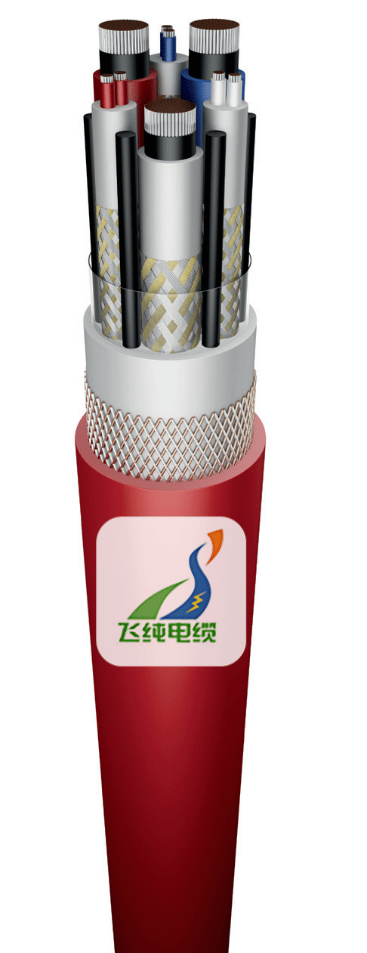Type O2nGcekż/w-G2 1.9/3.3kV Screened mining cables
13-core Power cables for mobile and portable receivers with six working cores for rated voltage 1.9/3.3 kV


These are heavy-duty, screened power cables designed for mobile and portable receivers used in underground mining.
They are built to meet the rigorous demands of harsh underground conditions and are rated for voltages of 1.9/3.3 kV, in accordance with the standard ZN-KFK-011/1999.
Cable Construction
Conductor Cores
Working Cores:
There are six working cores made from multi-stranded, tinned copper wires (Class 5 per PN-EN 60228).
Each working core is insulated with a heat-resistant rubber (IEP) that meets the PN-89/E-29100 standard.
The cores are color-coded: two blue, two natural, and two red.
Auxiliary Cores:
In addition to the working cores, the cable includes auxiliary cores with the same color coding (2 blue, 2 natural, 2 red).
Separator
A polyester foil sheath is used to separate the working cores.
Screening
The cable is provided with a screen over both the working cores and the insulation of the auxiliary cores.
This screen is constructed using a conducting tape along with a braid made of tinned copper wires (0.30 mm in diameter) and plastic yarn, ensuring a minimum coverage of 75%.
Additional Coatings and Layers
The auxiliary cores are further coated with a type of rubber (either IZ or IEP according to PN-89/E-29100).
The six working cores are twisted together and then integrated into a group along with the insulated, screened auxiliary cores.
An inner sheath made from ON5 rubber (as per PN-89/E-29100) provides extra protection.
An overall metallic shield, made of a braided layer of tinned copper wires (with a minimum cross-sectional area of 16 mm²), is applied over a non-metallic screen. This shield is then wrapped with a swelling tape.
Finally, a robust outer jacket (or “opona”) is applied. It is a two-layer construction made of ON4 rubber with a polyamide braid inserted between the layers, and it is red in color. This jacket is designed to resist flame spread and oil.
Electrical and Mechanical Characteristics
Test Voltages
Working Cores: Withstand up to 7.5 kV.
Auxiliary Cores: Withstand up to 2 kV.
Packaging and Dimensions
The cables are typically supplied on drums with a standard length of 250 meters.
Example configuration:
Core Arrangement: 6 working cores of 50 mm² each, plus a 25 mm² neutral, and 6 auxiliary cores of 2.5 mm² each.
Working Core Insulation Thickness: Approximately 2.4 mm.
Outer Jacket Thickness: Two layers (1.5 mm and 2.5 mm).
Approximate Overall Diameter: 61.6 mm.
Unit Mass: About 6715 kg per kilometer.
Continuous Current Capacity: Approximately 190 A (based on the six loaded working cores).
Durability and Operating Conditions
The cable shows excellent resistance to impact, abrasion, and tearing.
The outer jacket is resistant to both flame spread and oil.
Temperature Range:
Ambient temperatures from -30°C to +50°C.
Maximum operating temperature up to +90°C.
Bending Radius: The minimum recommended bending radius is eight times the cable’s overall diameter.
Applications
These cables are specifically engineered for use in extremely demanding underground mining environments. They are intended to power mobile mining equipment, including machinery like continuous miners (often referred to as “kombajny”), ensuring reliable performance under severe conditions.

Frequently Asked Questions (FAQ)
Q1: What is the primary application of these mining cables?
A1: These cables are designed for powering mobile and portable equipment in underground mining operations, including continuous miners and other heavy machinery operating in harsh underground environments.
Q2: What is the rated voltage for the cable?
A2: The cable is rated at 1.9/3.3 kV, making it suitable for the demanding voltage requirements of mining applications.
Q3: How many working cores does the cable have and what are they made of?
A3: The cable contains six working cores made of multi-stranded, tinned copper wires (Class 5 per PN-EN 60228), ensuring both electrical reliability and flexibility in rugged conditions.
Q4: What type of insulation is used for the working cores?
A4: The working cores are insulated with a heat-resistant rubber (IEP) that meets the PN-89/E-29100 standard, providing durability and protection against high temperatures encountered in mining environments.
Q5: How does the cable ensure proper electrical screening?
A5: The cable features a robust screening system, which includes a polyester foil separator over the working cores and an additional metallic screen composed of tinned copper wire braid (with a minimum geometric cross-section of 16 mm²). This ensures excellent electromagnetic compatibility and interference protection.
Q6: What additional layers contribute to the cable’s durability?
A6: In addition to the conductor insulation and screening, the cable has an inner sheath of ON5 rubber, a swelling tape on the metallic screen, and a robust, two-layer red outer jacket made from ON4 rubber with an interlay of polyamide braid for enhanced flame and oil resistance.
Q7: What are the operating temperature ranges for these cables?
A7: The cables are designed to operate in ambient temperatures ranging from -30°C to +50°C, with a maximum operating temperature of up to +90°C, ensuring reliable performance under varying environmental conditions in mines.
Q8: What mechanical properties make these cables suitable for mining?
A8: They exhibit excellent resistance to impacts, abrasion, and tearing—qualities that are essential for the rough and challenging conditions often found in underground mining environments.
Q9: How are these cables packaged and delivered?
A9: The cables are typically supplied on drums, with a standard length of 250 meters per drum. This packaging facilitates easy handling, transportation, and installation on mining sites.
Q10: What is the recommended bending radius for these cables during installation?
A10: To prevent damage, the minimum recommended bending radius is eight times the overall cable diameter, ensuring the cable maintains its integrity during installation and use in confined mining areas.






Type O2nGcekż/w-G2 1.9/3.3kV Screened mining cables
Type O2nGcekż/w-G2 1.9/3.3 kV mining cable is engineered specifically for the demanding conditions of underground mining. It features six high-quality working cores made from tinned, multi-stranded copper wires, each insulated with heat-resistant rubber for reliable performance even at high temperatures. A polyester foil separator and a robust metallic screen—with a minimum cross-section of 16 mm²—ensure excellent protection against electromagnetic interference. The cable’s design is further enhanced by additional protective layers, including an inner rubber sheath and a durable two-layer red outer jacket that resists impacts, abrasion, flame spread, and oil. With a wide operating temperature range (ambient -30°C to +50°C, and up to +90°C in operation) and a recommended bending radius of eight times its diameter, this cable is ideal for powering mobile mining equipment in harsh underground environments.
6/30/20214 min read
